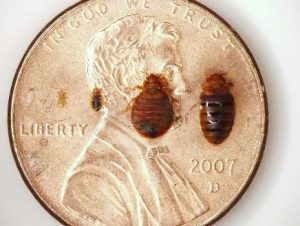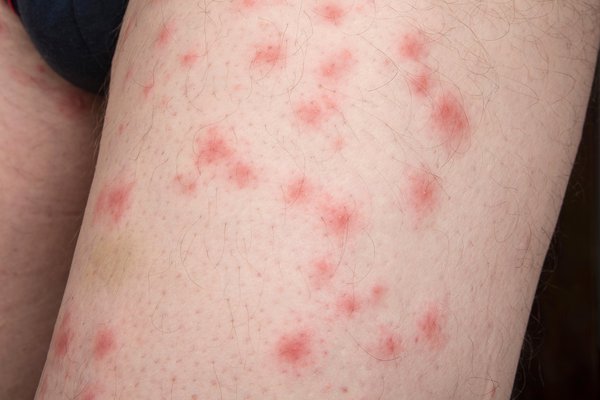
Top Ten Tips to Prevent or Control Bed Bugs
“Coos EH does not have resources to eradicate bed bugs from a property. As described below, a successful approach to eliminate bed bugs may require cooperation between all residents in a building, any others with a vested interest in the property along with good service from a licensed pest control company.”

1. Make sure you really have bed bugs, not fleas, ticks or other insects.
If you think you’ve caught a bed bug compare it to the photos here or an agent at Oregon State University Extension may be very helpful in identifying it.
2. Don’t panic! – It can be difficult to eliminate bed bugs, but it’s not impossible. Don’t throw out all of your things because most of them can be treated and saved. Throwing stuff out is expensive, may spread the bed bugs to other people’s homes, and could cause more stress.
3. Think through your treatment options – Don’t immediately reach for the spray can. Be comprehensive in your approach. Try other things first. Integrated pest management (IPM) techniques may reduce the number of bed bugs and limit your contact with pesticides. If pesticides are needed, always follow label directions or hire a professional. Learn more about treatment options: Non-Chemical Bed bug treatment
4. Reduce the number of hiding places – Clean up any clutter. A cluttered home provides more places for bed bugs to hide and makes locating and treating them harder. If bed bugs are in your mattress, using special bed bug covers (encasements) on your mattress and box springs makes it harder for bed bugs to get to you while you sleep. Leave the encasements on for a year. Be sure to buy a product that has been tested for bed bugs and is strong enough to last for the full year without tearing.
5. Regularly wash and heat-dry your bed sheets, blankets, bedspreads, and any clothing that touches the floor. This reduces the number of bed bugs. Bed bugs and their eggs can hide in laundry containers/hampers Remember to clean them when you do the laundry.
6. Do-it-yourself freezing may not be a reliable method for bed bug control. While freezing can kill bed bugs, temperatures must remain very low for a long time. Home freezers may not be cold enough to kill bed bugs. Putting things outside in freezing temperatures could kill bed bugs, but there are many factors that can affect the success of this method.
7. Kill bed bugs with heat, but be very careful. Raising the indoor temperature with the thermostat or space heaters won’t do the job. Special equipment and very high temperatures are necessary for successful heat treatment. Black plastic bags in the sun might work to kill bed bugs in luggage or small items if the contents become hot enough. Bed bugs die when their body temperature reaches 113°F (45°C). To kill bed bugs with heat, the room or container must be even hotter to ensure sustained heat reaches the bugs no matter where they are hiding.
8. Don’t pass your bed bugs on to others. Bed bugs are good hitchhikers. If you throw out a mattress or furniture that has bed bugs in it, you should slash or in some way destroy it so that no one else takes it and gets bed bugs. If you live in an apartment building where there is an infestation notifying property management will be helpful to both your neighbors and the building owner.
9. Reduce the number of bed bugs to reduce bites. Thorough vacuuming can get rid of some of your bed bugs. Carefully vacuum rugs, floors, upholstered furniture, bed frames, under beds, around bed legs, and all cracks and crevices around the room. Change the bag after each use so the bed bugs can’t escape. Place the used bag in a tightly sealed plastic bag and then in an outside garbage bin.
10. Turn to the professionals, if needed. Hiring an experienced, responsible pest control professional can increase your chance of success in getting rid of bed bugs. If you hire an exterminator, be sure it’s a company with a good reputation and request that it use an IPM approach.

What are the signs and symptoms of a bed bug infestation?
One of the easiest ways to identify a bed bug infestation is by the tell-tale bite marks on the face, neck, arms, hands, or any other body parts while sleeping. However, these bite marks may take as long as 14 days to develop in some people so it is important to look for other clues when determining if bed bugs have infested an area. These signs include:
- the bed bugs’ exoskeletons after molting,
- bed bugs in the fold of mattresses and sheets,
- rusty–colored blood spots due to their blood-filled fecal material that they excrete on the mattress or nearby furniture, and
- a sweet musty odor.

How do I know if I’ve been bitten by a bed bug?
It is hard to tell if you’ve been bitten by a bed bug unless you find bed bugs or signs of infestation. When bed bugs bite, they inject an anesthetic and an anticoagulant that prevents a person from realizing they are being bitten. Most people do not realize they have been bitten until bite marks appear anywhere from one to several days after the initial bite. The bite marks are similar to that of a mosquito or a flea.

Bed bugs are found across the globe from North and South America, to Africa, Asia, and Europe. Although the presence of bed bugs has traditionally been seen as a problem in developing countries, it has recently been spreading rapidly in parts of the United States, Canada, the United Kingdom, and other parts of Europe. Bed bugs have been found in five-star hotels and resorts and their presence is not determined by the cleanliness of the living conditions where they are found.
Bed bug infestations usually occur around or near the areas where people sleep. These areas include apartments, shelters, rooming houses, hotels, cruise ships, buses, trains, and dorm rooms. They hide during the day in places such as seams of mattresses, box springs, bed frames, headboards, dresser tables, inside cracks or crevices, behind wallpaper, or any other clutter or objects around a bed. Bed bugs have been shown to be able to travel over 100 feet in a night but tend to live within 8 feet of where people sleep.
- Inspect any room where you will be staying for the presence of bed bugs. You generally can do this without any extra tools but a flashlight can be useful.
- Check the mattress and headboard before sleeping.
- Inspect luggage racks.
- In hotel rooms, use luggage racks to hold your luggage when packing or unpacking rather than setting your luggage on the bed or floor. Try to keep luggage away from bed.
- Upon returning home, unpack directly into a washing machine and inspect your luggage carefully. Remember that time in a dryer at high temperatures kills the bed bugs (just washing will generally not kill bed bugs).
- Store suitcases away from your bedroom, such as in the basement or garage. Never store suitcases under your bed.
- Deal with a licensed pest management company employing credentialed professionals.
- Assure the pest management company is licensed and in good standing with ODA. Look for a friend who has had success working with a pest control company.
- Look for company experience resolving bed bug infestations.
- Buy value, not price. Beware of bargains that sound too good to be true.
- Don’t rush to make a decision
- Before signing a contract: Understand the nature of the work to be performed, the extent of the infestation, and what is covered by the service agreement
- Find out if the pest control company has liability insurance to cover any accidental damage during treatment; If a guarantee is given, know what it covers, how long it lasts and what you must do to keep it in force especially if a sizable amount of money is involved
